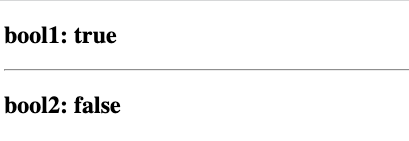How to render a boolean value in React JSX
In React, we use String()the function to render Boolean values in JSX, for example <h2>{字符串(bool1)}</h2>. By default, Boolean values don't render anything in React, so we have to convert the value to a string in order to render it.
export default function App() {
const bool1 = true;
const bool2 = false;
return (
<div>
<h2>bool1: {String(bool1)}</h2>
<hr />
<h2>bool2: {String(bool2)}</h2>
</div>
);
}

We have to convert the boolean values to strings in order to display them in our JSX code.
Ignore boolean values, null and undefined . They are not rendered at all.
None of the following JSX expressions render anything.
<div />
<div></div>
<div>{false}</div>
<div>{null}</div>
<div>{undefined}</div>
<div>{true}</div>
Alternatively, we can use the method on a Boolean value toString()to convert it to a string.
export default function App() {
const bool1 = true;
const bool2 = false;
return (
<div>
<h2>bool1: {bool1.toString()}</h2>
<hr />
<h2>bool2: {bool2.toString()}</h2>
</div>
);
}
Boolean.toString()Method returns a string representation of a Boolean value.
Another common approach is to use template literals to convert boolean values to strings.
export default function App() {
const bool1 = true;
const bool2 = false;
return (
<div>
<h2>{`bool1: ${bool1}`}</h2>
<hr />
<h2>{`bool2: ${bool2}`}</h2>
</div>
);
}
We use template literals to insert a boolean variable into a string.
请注意, the string is enclosed in backticks `` instead of single quotes.
The dollar sign and curly brace syntax allows us to use placeholders that are evaluated.
By default, template literals concatenate the parts into a single string.
For reprinting, please send an email to 1244347461@qq.com for approval. After obtaining the author's consent, kindly include the source as a link.
Related Articles
How to avoid cross-origin (CORS) issues in React/Next.js
Publish Date:2025/03/17 Views:170 Category:NETWORK
-
In this article, we will introduce how to avoid cross-origin (CORS) issues in React/Next.js. Cross-origin resource sharing (CORS) is a protocol that defines how web requests should be handled when crossing different URLs.
React Tutorial - Transferring Props
Publish Date:2025/03/16 Views:188 Category:React
-
React transfers Props. Props are generated when components are encapsulated. Components expose some properties (Props) to the outside world to complete some functions.
React Tutorial: Props Anti-Pattern
Publish Date:2025/03/16 Views:187 Category:React
-
React's Props anti-pattern, using Props to generate state in getInitialState is an anti-pattern - Anti-Pattern.
React Tutorial - Props Validation
Publish Date:2025/03/16 Views:102 Category:React
-
Props validation is a very useful way to use components correctly. It can avoid many bugs and problems as your application becomes more and more complex. In addition, it can make your program more readable.
React tutorial: Types of Props for child components
Publish Date:2025/03/16 Views:172 Category:React
-
Usually, the child components of a React component are a group, that is, the child components are an array. Introduction to Type of the Children Props.
How to solve the error Uncaught TypeError: Cannot read properties of undefined in
Publish Date:2025/03/16 Views:153 Category:React
-
In the process of React development, we often encounter some errors. Here we look at an error reported in App.js. The error is as follows: App.js:69 Uncaught TypeError: Cannot read properties of undefined (reading 'setState') at onInput
Why do you need to bind event handlers in React Class Components?
Publish Date:2025/03/16 Views:60 Category:React
-
When using React, we must have come across control components and event handlers. We need to use `.bind()` in the constructor of the custom component to bind these methods to the component instance. As shown in the following code:
Solution to the error "does not contain a default export" in React
Publish Date:2025/03/16 Views:191 Category:React
-
When we try to use `default import` to import from a module that does not have a `default export`, we get a "does not contain a default export" error. To fix the error, make sure the module has named exports and wrap the import in curly braces, e.g.
Error in React: Attempted import error 'X' is not exported from Solution
Publish Date:2025/03/16 Views:78 Category:React
-
In React, the error “Attempted import error 'X' is not exported from” in React.js occurs when we try to import a named import that does not exist in the specified file. To fix the error, make sure the module has named exports and you have not obfu

